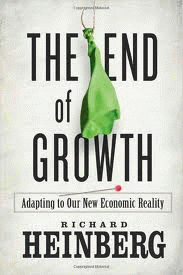Book Review
The End of Growth: Adapting to Our New Economic Reality
by Richard Heinberg
(New Society Publishers Aug 2011)
The basic premise of The End of Growth is that the world economy has flat-lined. Not only is it contracting, rather than expanding as many politicians claim, but there are important reasons why it will never return to the pre-2007 growth rates that characterized the last century.
Now that #OccupyWallStreet has seized control of the narrative around the banks that control the US government, the End of Growth will likely be the most important book of 2011. As well as making an ironclad case that the era of perpetual economic expansion has ended -- that the US, like most western nations, has become a Steady State economy -- Heinberg also gives examples of far-sighted governments (Japan, Sweden, Denmark, Norway and Finland) who have enacted policies to ensure the welfare of their citizenry as they confront the massive downsizing required by this new economic reality. Beyond organizing to end to corporate rule, #OccupyWallStreet needs to pressure the US and other western governments to abandon the pretense and enact similar measures.
Why Capitalism Hit the Wall in 2008
Heinberg and others in the Peak Oil/climate change movement have always argued that infinite economic expansion is mathematically impossible, given that we live on a planet with finite natural resources. They point to the massive ecological devastation caused by this reckless obsession with economic growth and warn that we are depriving our children and grandchildren of natural resources (fossil fuels, water, industrial fertilizers, fish stocks, top soil) that are essential for basic survival.
In Heinberg's previous work on resource scarcity, he envisions a timeline of a decade or more before the scarcity and prohibitive cost of natural resources (oil, coal, water, etc.) cause the capitalist economic system to hit the wall. In The End of Growth, he argues that it has already happened -- when global economic expansion ended in October 2008. His data shows that while a few countries can claim an occasional quarter of increased GDP, aggregate global economic growth is either stagnant or slowly contracting. Even China's so-called economic "miracle" hasn't been sufficient to generate a genuine increase in total global wealth.
Heinberg's new book is unique is that it combines his extensive research into resource depletion with an analysis of our flawed fractional reserve banking system. He is also the first, to my knowledge, to factor in the immense cost of the growing epidemic of natural disasters. Most (the floods, droughts, wildfires, landslides, etc.) relate to climate change. However some, like last year's Gulf oil spill, relate to the depletion of global oil and gas resources and the adoption of riskier methods of fossil fuel extraction.
In addition to quoting a number of highly placed financial business experts, like Microsoft CEO Steve Bollmar, who agree that global economic expansion has permanently ended, Heinberg also presents a wealth of statistical data. This includes graphs from John Williams of www.shadowstats.com, who argues that the US government is misrepresenting the true Gross Domestic Product (GDP), just like they misrepresent the true unemployment rate -- which is really 16-18%. According to Williams, after government figures are adjusted for inflation and methodological reporting changes, 2010 GDP actually decreased by 1%.
The Ultimate Ponzi Scheme
Even a look at conventional World Bank and IMF data leaves the clear sense that the American public is being systemically lied to. Although we are told that total global wealth has nearly returned to its 2007 high of $63 trillion, this figure doesn't take account of the $40 trillion owed by the US and other governments nor the $60 trillion of debt owed by banks, businesses and households. Even if global GDP does increase by 3% per year (which, as Heinberg clearly shows, it won't), 3% of $63 trillion barely covers interest payments on a $100 trillion debt, much less paying down the original loans.
Yet as Heinberg points out, none of these numbers represent true wealth. Under the fractional reserve lending system, this debt has been invented out of thin air by banks to generate interest payments. As he points out, it's the ultimate Ponzi pyramid scheme. It only works so long as suckers keep putting money into it. In a global monetary system where money is created through bank loans, there is never enough money in the system to pay back all the debts with interest. This type of system can only continue to function so long as there is continued growth. It's precisely because economic expansion has stopped, Heinberg argues, that the world confronts its current massive debt crisis.
(Note: You can view every article as one long page if you sign up as an Advocate Member, or higher).






